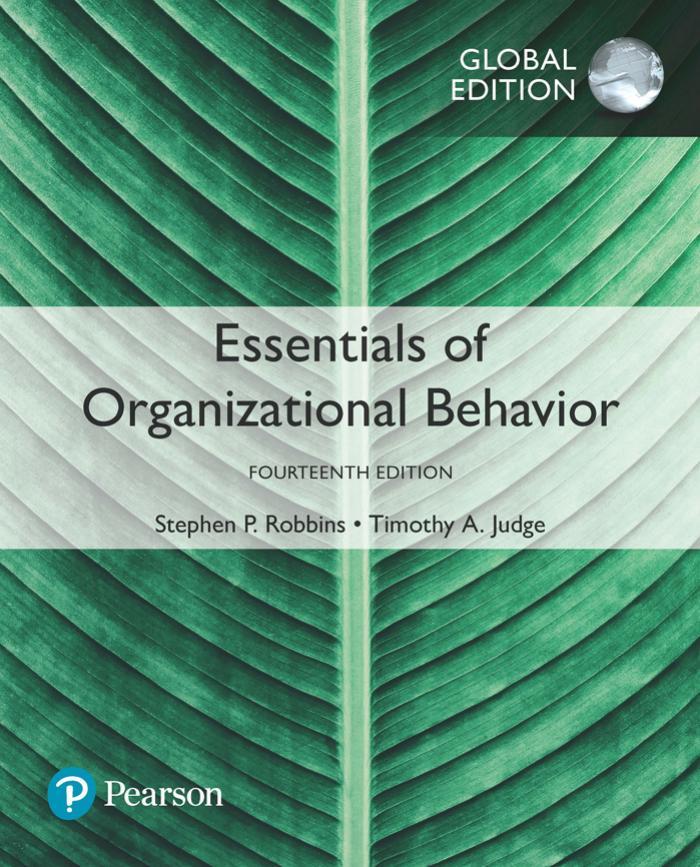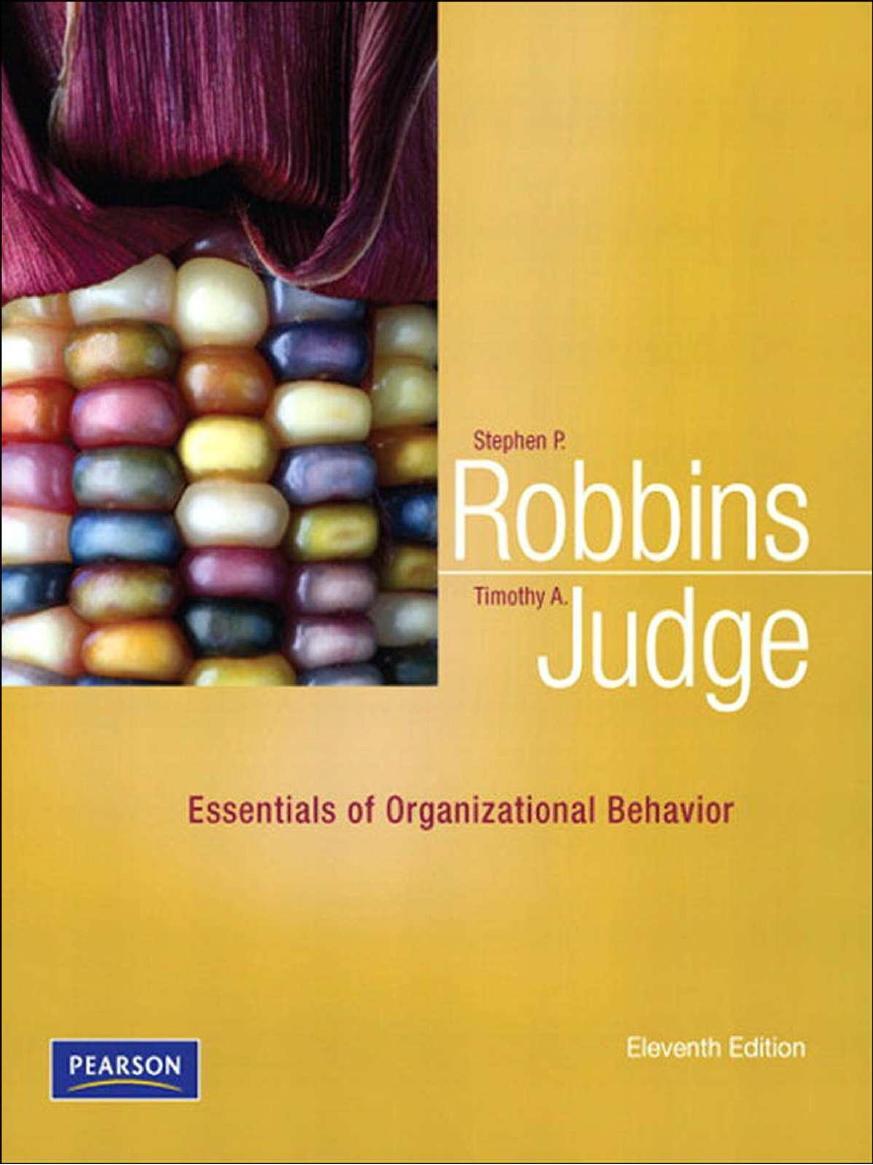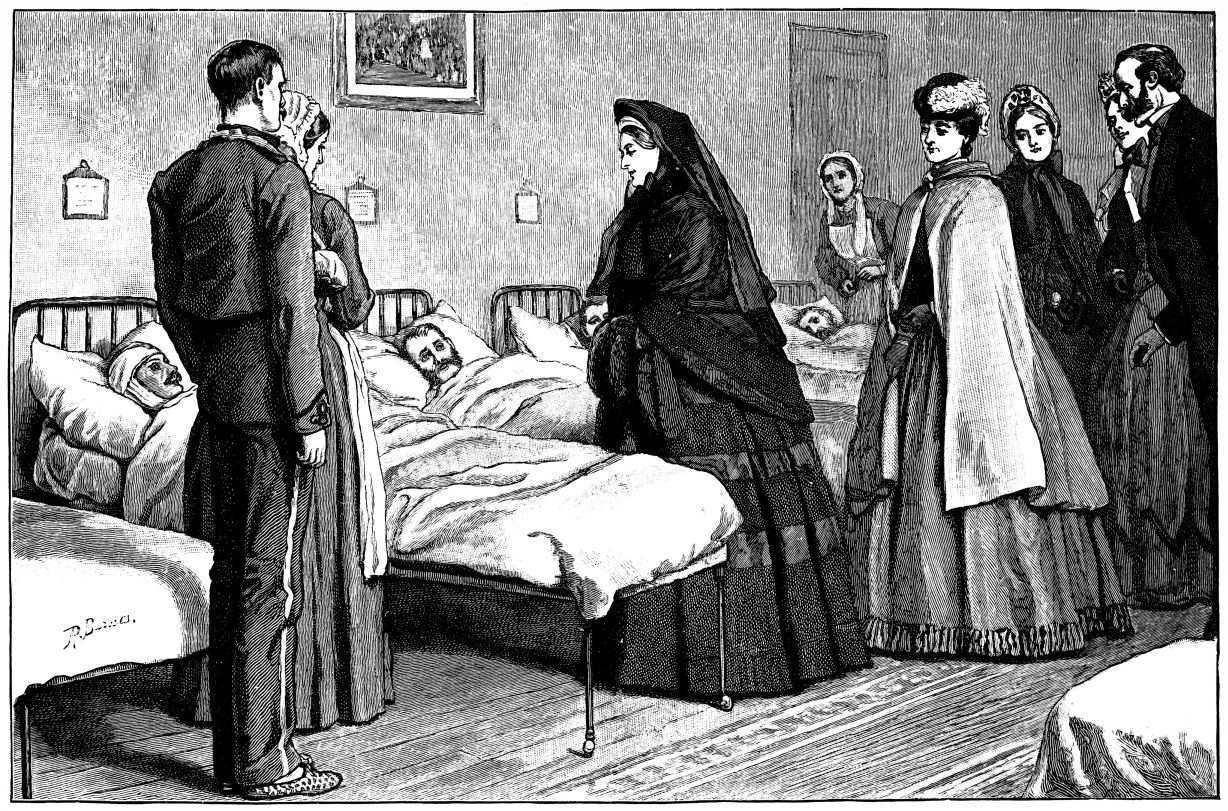Exploring the Variety of Random Documents with Different Content
is a heavy loss, a severe blow! My own darling had the very highest esteem, regard, and respect for dear Sir Cornewall Lewis; we delighted in his society; we admired his great honesty and fearless straightforwardness. We had the greatest confidence in him, and since my terrible misfortune, I clung particularly to characters like his, which are so rare. I felt he was a friend, and I looked to him as a support, and a wise and safe counsellor. He is snatched away, and his loss to me and to the country is irreparable. How little did I think, when I talked to him the last time here, and he spoke so kindly of my popularity, as he so kindly expressed it, that I should never see his kind face again.”[169] He was leader of “the Court Party” in the Cabinet, and was succeeded at the War Office by Earl de Grey.
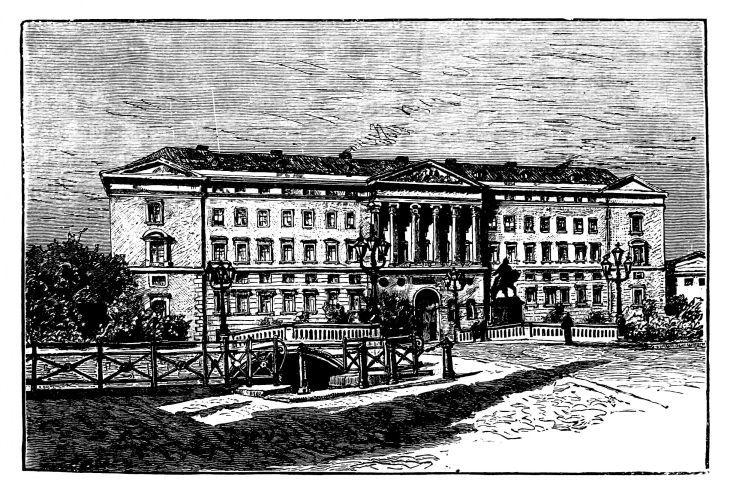
Only one question provoked anything resembling a party division during the Session, and that was the Prison Ministers Bill. The object of the measure was to allow prisoners to be attended by clergy of their own denominations and persuasions. As the Roman Catholics would derive most benefit from the Bill, it was opposed warmly by a powerful body of the Tory
CHRISTIANSBORG CASTLE, COPENHAGEN.
Party. The Liberals naturally supported the measure, and on this occasion they were joined by a few of the more enlightened Conservatives, such as Lord Derby, Mr. Disraeli, Mr. Henley, and Sir John Pakington. As Mr. Disraeli was at the time favouring an intrigue for detaching the Roman Catholic Party from the Liberals, it was with ill-concealed chagrin that he listened to the bigoted attacks of his followers on the Bill, which was, however, passed. The suspension of amicable relations with Brazil,[170] the vote for the purchase of the Exhibition Buildings, the reorganisation of the London police, and the attitude of the Government to the belligerents in the American Civil War, were the only other topics that created serious or practical Parliamentary discussion.
The vote for the purchase of the Exhibition Building of 1862 was extremely unpopular, and but for the Queen’s influence it would probably have been rejected by the House of Commons. The country even then viewed with strong suspicion the tendency to centralise all National collections in the distant Court suburb of Kensington. It was also insinuated that the Royal Family had pecuniary interests in building land, the value of which would be enhanced by creating a Science and Art Department in this quarter. That insinuation is contradicted by Sir Theodore Martin, who asserts that Prince Albert never was able to save any money out of his private income to purchase such lands for his heirs.[171] This perhaps accounts for what has long been a popular mystery—the fact that his will was never submitted to Probate. As a matter of course, if he had no money to leave to his heirs, the Prince must have left no will that was worth proving. But in 1863 these insinuations had sunk deep in the public mind, and the manner in which Lord Palmerston managed the question gave colour to them. He knew that the proposal to buy the Exhibition Building of 1862 was hateful to the taxpayers. The edifice was architecturally unfit for the reception of a permanent national collection of paintings, and its distance from London rendered all schemes for transferring to it the pictures from the National Gallery in Trafalgar Square objectionable in the extreme. Palmerston, however, at the outset disarmed his critics by proposing merely to buy from the Exhibition Commissioners, for £67,000, the site of the Exhibition, and it was tolerably cheap for a metropolitan site, in days when land in the City fetched £119,000 an acre. This site, he said, was wanted for a building to house the new Patent Office, some natural history collections from the British Museum, and for a National Portrait Gallery. Then he asked the
House of Commons to vote £120,000 for the purchase of another “lot” of seventeen acres belonging to the Commissioners adjacent to the Exhibition site, and, finally, he desired it to vote £80,000 for the building itself. Very artfully he had the votes put separately, and Mr. Gladstone aided him by positively assuring the House that the project of buying the building—which was universally unpopular—was one quite apart from the other projects. By a vote of 267 to 135 the House agreed, but grudgingly, to the purchase of the ground, intending to fight the taxpayers’ battle on the question of buying the building. When, however, they came to the vote for the building, Mr. Gladstone informed them they had no option but to purchase it, for the contractors were under no obligation to remove it—a fact which Lord Palmerston had carefully concealed from the House. Members were thus in possession of a site burdened with a useless building which it was nobody’s business to remove. If the Government pulled it down, and then put up another structure in its place, the operation would cost much more than the £105,000 which were needed to buy and adapt it to public uses. The House was furious at finding itself trapped by Lord Palmerston and Mr. Gladstone. Bitter complaints of Courtly jobbery were heard on all sides, and a Ministerial defeat was the result. Lord Malmesbury, writing on the 5th of July in his “Diary,” says:—“Several people called, who told me that the scene in the House of Commons when the division took place on the vote for the purchase of the Exhibition Building was extraordinary. Sir Stafford Northcote’s speech[172] was the signal for a storm, and he was forced to sit down. Disraeli had canvassed his supporters, telling them that he had a letter in his pocket from the Queen. This had a disastrous effect, and when he got up the hooting was so terrific that he could not be heard. Gladstone’s speech had already excited great indignation, for it showed how completely the Government had deceived the House when Lord Palmerston had induced them to vote for the purchase of the land, leaving them under the delusion that the contractors for the Exhibition were bound to remove the building if it was not sold within a certain time. Gladstone had told them that there was no engagement of the sort, and that he believed they were not obliged to remove it at all. This, whether true or not, was taken as a menace to force them to buy the building, and infuriated the House of Commons the more, as Lord Elcho proved that the purchase would be a most disadvantageous one, entailing an enormous expense. So the House rose en masse, and, after a scene of the utmost confusion and excitement, defeated the Government by
more than two to one, Gladstone and Disraeli looking equally angry.”[173] It need hardly be said that Mr. Disraeli’s indiscreet use of the Queen’s name in this questionable transaction was unwarranted and unwarrantable.
The inefficiency displayed by the City Police at the entry of the Princess Alexandra into London tempted Sir George Grey to propose that the Metropolitan and City Forces should be amalgamated under the control of the Home Office. This was hotly opposed. The Lord Mayor and Mr. Alderman Sidney protested against a scheme for giving the Home Secretary control of what might become a large standing army in the City of London. [174] Other members raised the cry of “centralisation,” and denounced the measure as an attack on the principle of local self-government. It was now the turn of London to be assailed, but Manchester and Birmingham and all other powerful cities would soon share the fate of the Metropolis. All over England municipal bodies naturally made common cause with the City of London, and it was soon apparent that the Government must either bend or break. Luckily it was discovered that the Bill was not a public but a private Bill, and, as such, subject in respect of notices to certain Standing Orders which had not been obeyed. This omission gave Sir George Grey a technical excuse for withdrawing it.
Vigorous efforts were made during 1863 to induce the Government to recognise the Southern Confederacy, but they were made in vain. Mr. Roebuck, in the House of Commons, proposed a motion in favour of recognition, alleging that in an interview with Napoleon III. he had discovered that France would co-operate with England for that purpose— nay, he warned Lord Palmerston that France might recognise the South without waiting for our co-operation. The Tory Party, though strongly sympathising with Mr. Roebuck’s views, were restrained by their leaders from harassing the Cabinet, and it was the general feeling that Ministers should be left quite free to act. As for the Government, through Lord Palmerston and Lord Russell, it repeatedly declared that it was bent on adhering to a policy of scrupulous neutrality. But this was a matter of some difficulty. Many Englishmen had engaged in the lucrative trade of blockaderunning. When their vessels failed to pass the Federal cordon round the Southern ports, and were seized, their owners, as Lord Russell said, “put on an air of injured innocence, and came to the Foreign Office demanding redress.” In Parliament, too, their friends attacked Ministers for meekly submitting to violations of International Law by officers of the Federal
Navy, and the investigation of these cases, especially when the seizures were of doubtful legality, raised many irritating controversies between the two Governments. Swift-armed cruisers were built in English ports for the Confederate States, and then taken out to sea, and fitted with their guns and armaments. The difficulty of preventing their escape—at all times serious— was aggravated by the uncertain state of English law on the subject. One of these cruisers, the Alabama, had been allowed to sail from the Mersey, and had committed fearful depredations on Federal commerce. The American Government alleged that her escape was due to Lord Russell’s culpable negligence. The truth was that the Government meant to arrest the Alabama, but owing to the temporary mental derangement of the Judge AdvocateGeneral there was delay in going through certain legal formalities, and before this was overcome the ship had put out to sea. On the other hand, when another vessel of the same class—the Alexandra—was seized, her seizure was pronounced illegal by the English Law Courts. Lord Russell’s action was either too slow or too quick, and in each case it served to irritate both North and South. But the country gave the Government a generous support, recognising their sincerity in endeavouring to maintain a neutral policy, in spite of the pressure which was put upon them by Southern partisans.
In America the war dragged slowly on. On the 1st of January Mr. Lincoln’s Proclamation abolishing slavery in the rebel States took effect, but without producing a servile insurrection, as was anticipated. After
MEMORIAL OF THE GREAT EXHIBITION IN THE ROYAL HORTICULTURAL SOCIETY’S GARDENS, SOUTH KENSINGTON.
the drawn battle of Murfreesborough, with which the year 1862 closed, and the Federal defeat at Fredericksburg, the efforts of the North were chiefly directed against Charleston. In April Admiral Dupont was repulsed in an attack on the harbour, and in summer Admiral Dahlgren resumed siege operations, but without success. In May General Hooker led the Army of the Potomac across the Rappahannock, and took up positions above and below that held by the Confederates at Fredericksburg. Lee, by a rapid movement westward, crushed Hooker’s force at Chancellorsville, and then suddenly doubling back easily defeated Sedgwick’s division which had occupied Fredericksburg. The Army of the Potomac retraced its steps across the Rappahannock, and Richmond was no longer menaced. On the 4th of July Grant captured Vicksburg after a series of brilliant operations, and then Port Hudson surrendered to Banks. This was a great gain for the Federals, for not only did they clear the Mississippi of rebels, but the powerful garrisons, with their material of war, which President Davis had, by an inconceivable blunder, shut up in the river forts, fell into their hands. At the beginning of summer Lee outflanked Hooker, defeated Milroy on the Shenandoah, and then, by a daring movement, crossed the Potomac, and, to the terror of the Government at Washington, carried the war into Maryland and Pennsylvania. Hooker was dismissed, and Meade, summoning all available troops to his standard, marched in haste to arrest Lee’s progress. They met at Gettysburg, where, after terrible slaughter, Lee confessed his failure, and retreated unmolested to Virginia.[175] Beauregard’s successful defence of Charleston consoled the Confederates for the failure of Lee’s invasion of Maryland and Pennsylvania, and in September they were further cheered by Longstreet’s victory over Rosecrans at Chickamauga in Tennessee. Though the obstinate valour of General Thomas’s division enabled Rosecrans to rally his troops on Chattanooga heights, the position of the Federals in Tennessee was perilous. Rosecrans at Chattanooga, and Burnside at Knoxville, were separated in the midst of a hostile population, and Lee was hurrying on reinforcements to strengthen General Bragg, who was threatening the Federal Commanders. On the other hand, Grant, who had the chief command in this region, was reinforced by Sherman, and he determined to attack Bragg as the easiest way of relieving Burnside. This he did on the 23rd of November at Missionary Ridge, his plan being to overwhelm Bragg’s right by hurling masses of Sherman’s troops against it till he broke it up. When Sherman was repulsed, the Federals then attacked the left centre of the
Confederate position, compelling Bragg to retreat to the frontier of Georgia. Grant then fell back on Chattanooga, Burnside holding his entrenchments at Knoxville, from which Longstreet drew off his forces. Thus, though the Northern campaign in Virginia was unsuccessful, the Federals were masters of the Mississippi and of Tennessee when the year closed. The Confederate Government, failing to induce Lord Russell to recognise the Southern States, withdrew their envoy, Mr. Mason, from London.
In early summer (8th May) the Queen and the Princess Alice paid a visit rather unexpectedly to Netley Hospital, the foundation-stone of which had been laid seven years before by the late Prince Consort. She visited ward after ward, conversed with the invalided soldiers in a soft, low voice, questioning
the officials about their cases, and even penetrated to the married men’s quarters, where she carefully inquired into the comfort of the soldiers’ wives and their families. One of the men, in whose case she had interested herself, was dying, and in broken accents exclaimed, as she went away, “I thank God that He has allowed me to live long enough to see your Majesty with my
VISIT OF THE QUEEN TO NETLEY HOSPITAL.
own eyes.” On the 9th of June the Queen and the younger members of her family came to town from Windsor to inspect privately the memorial of the Great Exhibition—which also took the character of a memorial to the late Prince Consort—in the Royal Horticultural Society’s Gardens at Kensington. It was inaugurated next day by the Prince and Princess of Wales, attended by a company of ladies and gentlemen from the Court.
On the 12th of June the Queen received an extraordinary address on the birthday of the late Prince Consort from the ballast-heavers of the Port of London, which touched her very deeply. In it they said, “Before he (Prince Albert) came to our aid we could only get work through a body of riverside publicans and middlemen, who made us drink before they would give us a job, made us drink while we were at it, and kept us waiting for our wages, and drinking after we had done our work, so that we could only take half our wages home to our families, and that half too often through a drunkard’s hands.” The Prince, it seems, on getting an appeal from them, privately persuaded the Government to insert a clause in the Merchant Shipping Act putting these men under the control of the Corporation of Trinity House. Then he used his influence in the Corporation to pass rules for the employment of ballast-heavers, which met most of their grievances, and he even gave them a house where they might wait for work, supplied it with papers and books, and helped them to start a benefit society. The men said in their address that they were in the habit of celebrating their deliverance from bondage by an annual treat on the Queen’s birthday, and they added, “Your Majesty will not wonder that we then think with equal gratitude of our deliverer. He year by year asked after us, and rejoiced to hear of our improvement while he lived on earth.” They were, however, desirous of having a portrait of the Prince to hang in their room, and begged the Queen to give them one. “We hope,” they said, “your Majesty will excuse our boldness in asking this favour, but we feel we may speak to our Prince’s wife; and, therefore, praying you to grant our humble request, we are your Majesty’s most obedient and faithful servants.” The Queen’s answer came from her heart. It was as follows:—
“W������ C�����, June 12
“M� D��� S��, I have had the honour to lay before her Majesty the Queen the address from the ballast-heavers of the Port of London, which you have forwarded to me for presentation Her Majesty has been deeply touched by this spontaneous testimony to the active benevolence of her beloved husband, and amongst all the tokens of
sympathy in her grief, which she has gratefully received from all classes of her people, no one has been more gratifying to the Queen, and no one more in harmony with her feelings, than the simple and unpretending tribute from these honest, hard-working men. I am commanded to request that you will assure the ballast-heavers that the interest in their welfare, so especially displayed by him whose life was employed in endeavouring to benefit the people of this country, is fully shared by her Majesty, and that her Majesty rejoices to hear of the happy change in their moral and social condition. The Queen has the greatest pleasure in complying with the request contained in the address, and has ordered two prints of the Prince Consort, one in uniform and one in ordinary dress, to be framed and presented, to be hung in the room in which the ballast-heavers wait; to these her Majesty has added one of herself, as the Queen would wish, in the remembrance of these grateful men, to be associated with her great and good husband, whose virtues they have so highly and justly appreciated.
“Believe me, sincerely yours,
“C. B. P�����.”
“Fredk J Furnivall, Esq ”
Nor was this the only occasion during the year on which the Queen manifested her vigilant interest in the lot of her poorer subjects. In July a wretched woman named Geneive had been forced by her husband to walk on a rotten tight rope, suspended thirty yards above the ground, at a Foresters’ Fête in Aston Park, Birmingham. The rope broke, and the poor creature, who was far advanced in pregnancy, was dashed to pieces in the most shocking manner. Yet the fête was continued, the Committee callously determining “to go on with the programme, omitting the dangerous parts.” On the 25th of July the Mayor of Birmingham was somewhat startled to receive from Sir C. B. Phipps a letter in the following terms:—“The Queen has commanded me to express to you the pain with which her Majesty has read the account of a fatal accident which has occurred during a fête at Aston Park, Birmingham. Her Majesty cannot refrain from making known through you her personal feelings of horror that one of her subjects—a female—should have been sacrificed to the gratification of the demoralising taste, unfortunately prevalent, for exhibitions attended with the greatest danger to the performers. Were any proof wanting that such exhibitions are demoralising, I am commanded to remark that it would be at once found in the decision arrived at to continue the festivities, the hilarity, and the sports of the occasion after an event so melancholy. The Queen trusts that you, in common with the rest of the townspeople of Birmingham, will use your influence to prevent in future the degradation to such exhibitions of the Park which was gladly opened by her Majesty and the beloved Prince Consort, in
the hope that it would be made serviceable for the healthy exercise and rational recreation of the people.” The Mayor explained that when he became a patron of the fête he did not know that a dangerous exhibition was contemplated, and though Aston Park was outside his jurisdiction, he promised to use his influence to prevent such exhibitions from being held there in future.
On the 11th of August the Queen left London for Antwerp, from which she proceeded to Laeken with the King of the Belgians. From Belgium she went on to Gotha, where she stayed at the Castle of Rosenau till the 7th of September. On the 8th of the month her Majesty journeyed to Kranichstein, near Darmstadt, and spent the day with the Princess Louis of
THE QUEEN UNVEILING THE STATUE OF PRINCE ALBERT AT ABERDEEN.
Hesse. Leaving at night, the Queen was in Antwerp early next morning (9th), and on the 10th at Greenhithe, whence the Fairy, steam tender to the royal yacht, conveyed her to Woolwich. Driving to Nine Elms, she took train to Windsor, greatly pleased by the hearty greetings she received from crowds of people at the chief stations on the way. The autumnal holiday was, as usual, spent at Balmoral, where a kindly and sympathetic family party gathered round the Queen. Prince Louis of Hesse and the Princess (Alice) stayed with her at the Castle. The Crown Prince and Princess of Prussia, with their family, were lodged hard by at Abergeldie. The Princess Louis of Hesse devoted herself to her mother, and with characteristic energy endeavoured to dispel the heaviness of heart which was again settling on her. For this purpose she urged the Queen to resume the old open-air life among the mountains, from which she had derived incalculable benefit in times past. The Princess therefore organised an expedition to Clova, which her mother was induced to join. The party consisted of the Queen, the Princess Louis of Hesse, the Princess Helena, the Queen’s coachman, Smith, and her gillie, John Brown, and “Willem,” a little black page-boy in the service of the Princess Louis. The excursion was marred by an alarming accident which befell the party on the way home. The coachman lost his way in the dark, and about two miles from Altnagiuthasach the carriage was upset—the Queen being flung violently on her face to the ground. “Alice,” writes the Queen in her “Journal,” was “soon helped up, by means of tearing all her clothes to disentangle her; but Lenchen (Princess Helena), who had also got caught in her dress, called out very piteously, which frightened me a good deal, but she was also got out with Brown’s assistance, and neither she nor Alice was at all hurt. I reassured them that I was not hurt, and urged that we should make the best of it, as it was an inevitable misfortune.... Meantime the horses were lying on the ground as if dead, and it was absolutely necessary to get them up again. Alice, whose coolness was admirable, held one of the lamps while Brown cut the traces, to the horror of Smith, and the horses were speedily released, and got up unhurt.” The Queen’s commonsense advice to “make the best of it” was taken, and the Royal party encamped in this desolate mountain solitude, while Smith was sent on to get another carriage. Then the Princesses discovered that their mother had been bruised severely on the face, and that her right thumb was sprained. “A little claret,” the Queen says, “was all we could get either to drink or wash my face and hands.” Luckily, the groom, who had gone on in front with the “shelties,” or rough little mountain ponies, which the Queen and her family
use for hill climbing, got alarmed at their long absence, and he very sensibly rode back to see if any accident had happened. When he came up the Queen insisted on mounting at once and riding all the way home, which she reached after ten o’clock at night, to find the Crown Prince of Prussia and Prince Louis of Hesse at the door of the Castle anxiously looking out for her. A week after this accident (13th of October) the Queen was present at the inauguration of Marochetti’s statue to the Prince Consort at Aberdeen. “I could not reconcile it to myself,” she said, in replying to an address from the subscribers, “to remain at Balmoral while such a tribute was being paid to his (Prince Albert’s) memory, without making an exertion to assure you personally of the deep and heartfelt sense I entertain of your kindness and affection, and at the same time to proclaim in public the unbounded reverence and admiration, the devoted love, that fills my heart for him whose loss must throw a lasting gloom over my future life.” It was a mournful ceremony for the Queen, whose emotion was so great that she had to depute Sir George Grey, the Minister in attendance, to read her reply. Dense crowds of people filled the streets, but forbore to cheer, greeting the Royal widow merely with silent and respectful sympathy. In a letter to the Lord Provost of the city, the Queen, on her return to Balmoral, assured him how fully she appreciated the consideration which was shown for her feelings, not only by those who took part in the ceremony, but by the townspeople generally, “on an occasion which was one of severe and painful trial” for her. During the months of September and October the Princess Louis of Hesse was in attendance on the Queen, who was much cheered and benefited by her affectionate companionship. But her visit came to an end in October, when the Princess, in a letter to her Majesty written from Buckingham Palace, on her way to Darmstadt, says of her sojourn, “It was such a happiness to speak to you, and in return to hear all you had to say, to try and soothe you, and try to make your burthen lighter.... I can only say again, trust, hope, and be courageous, and every day will bring something in the fulfilment of your great duties which will bring you peace and make you feel that you are not forsaken, that God has heard your prayer, felt for you as a loving Father would, and that dear papa is not far from you.”[176] The 14th of December— the anniversary of the Prince Consort’s death—was passed in deep seclusion by the Queen at Windsor. As the year closed the country was relieved of all anxiety as to the Cotton Famine in Lancashire. The crisis had, indeed, passed early in summer, and the nation no longer feared that the calamity would
prove unmanageable. The history of the Cotton Famine may be termed a history of agreeable disappointments. It was predicted that the prostration of trade in Lancashire would deal a mortal blow at English commerce—that the revenue would dwindle to a vanishing point—that the problem of sustaining vast masses of pauperised labour, whose pauperism must be but the harbinger of general bankruptcy among their employers, would prove insoluble—that their starvation would breed pestilence and lead to outbreaks of violence and crime, ending with seditious attacks on the Government and all institutions that upheld law and order. Already it has been shown that commerce, so far from declining, flourished apace during 1862-63, and that the revenue increased so rapidly that Mr. Gladstone actually remitted taxes.
The problem of relieving the distress was solved with ease and simplicity. There were no epidemics of pestilence, and, save in Stalybridge, no riotous disturbances. The noble resignation, the heroic patience of the sufferers, and their perfect confidence in the sympathy and the helpfulness of their countrymen, in fact compelled the admiration of the civilised world. In the month of December, 1862, there were 500,000 cotton operatives receiving relief in Lancashire, and the loss in wages from lack of employment was estimated at £168,000. Cotton then came in, though in small quantities, and some mills were able to run. Emigration and the transference of labour to other employments also relieved the pressure, so that in June, 1863, only 256,000 persons were receiving relief in the afflicted districts. At the end of the year this number was reduced to 180,000. So far from the health of the people suffering, it rather improved. There was less infant mortality than usual in the cotton districts, possibly because female operatives, being thrown out of work, were able to devote more attention to their children.[177] Enforced
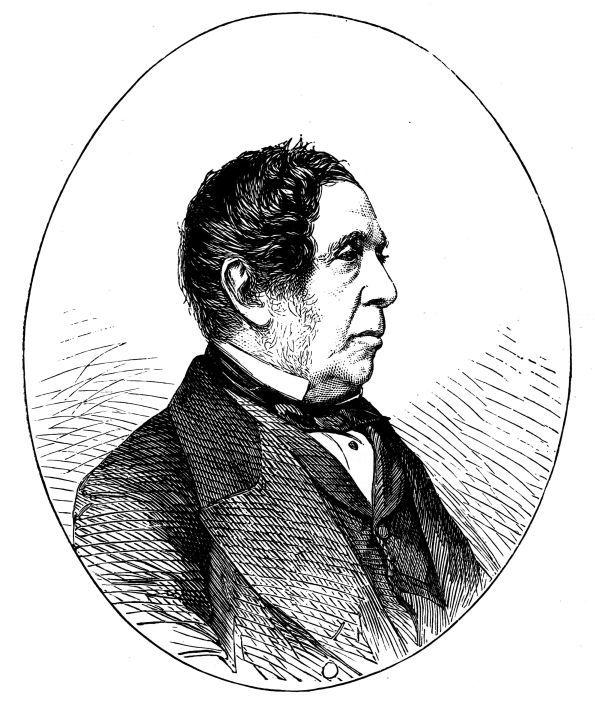
SIR CHARLES PHIPPS.
sobriety gave the people more power to resist disease, and sanitary precautions which, at the instance of the Executive Committee in Manchester, were taken by local authorities also tended to keep the villages wholesome. The funds by which distress was relieved came from special local rates levied by consent of Parliament in the unions; from loans raised
by local authorities under Parliamentary sanction, and spent on public works which gave employment to the operatives; and, last of all, from voluntary subscriptions, which were sent from all quarters of the world. At first it was thought that little could be expected from the cotton districts themselves. “Lancashire,” said Mr. Cobden to Lady Hatherton, “with its machinery stopped is like a man in a fainting fit. It would be as natural to attempt to draw money from the one as blood from the other.”[178] But in one form or another, in voluntary contributions, rates, loss of wages, depreciation of fixed capital, business losses, Lancashire spent an aggregate of £12,445,000 in coping with the Cotton Famine. Lancashire, indeed, raised £1,400,000 of the voluntary contributions received up to April, 1863, which came to £2,735,000. The work of administration was chiefly centred in the Executive Committee at Manchester, the President of which was the Earl of Derby. The voluntary labour at their command must have been very great, for the cost of administration came only to 15s. for every £100. What was afterwards called “the Conservative reaction” in Lancashire set in after this Fund was distributed, for in time, when the old generation of Radicals died out, their successors in the districts which had been saved from starvation by the almoners of the Fund, who were often zealous Anglicans, nearly all went over to the Tory Party. The Queen did her utmost to contribute to the success of the Fund, and her joy was unalloyed when she saw that its administrators had, in the beginning of 1864, averted the disaster that menaced her Northern Duchy.

THE ALBERT BRIDGE, WINDSOR.
CHAPTER VIII.
THE DANISH WAR.
Stagnant Politics Excitement over the Danish War Attitude of the Queen
Withdrawal of the Danes from Holstein Lord Wodehouse’s Mission The Quarterly Review advocates War Mr Disraeli Repudiates a War Policy Lord Palmerston’s Secret Plans The Case against Germany The Queen’s Warnings Mr. Cobden’s Arguments Lord Russell’s “Demands” Palmerston drafts a Warlike Queen’s Speech
The Queen Refuses to Sanction it Lord Derby Summoned to Osborne He is Pledged to a Peace Policy Austria and Prussia in Conflict with the Diet The Occupation of Sleswig War at Last Retreat of the Danes to Düppel Palmerston’s Protests Answered by German Victories The Invasion of Jutland Storming of the Düppel Redoubts Excitement in London Garibaldi’s Visit to London Garibaldi and the Dowager Duchess of Sutherland Anecdotes of Garibaldi’s Visit Clarendon’s Visit to Napoleon III. Expulsion of Garibaldi by Palmerston Napoleon III. Agrees to Accept the Proposal for a Conference Triumph of the Queen’s Peace Policy Palmerston’s Last Struggle His Ministry Saved by Surrender to Mr Cobden
The Treaty of Vienna End of the War.
T�� year 1864 gives one a vivid illustration of the stagnant condition of politics in England under Lord Palmerston. The mind of the country was absorbed in one question, and one only, namely, whether England should make war in Prussia and Austria to maintain the integrity of Denmark and uphold the Treaty of London. Ten years before, England had rushed headlong into war for a cause that was more shameful, and for “British interests” that were much more visionary than those which were now at stake. But great progress had been made during these ten years. The disasters and disgrace which had fallen on the nation during the Crimean struggle had not been endured for nothing. Englishmen had no longer boundless confidence in the aristocratic war party, whose clumsy diplomacy and military incapacity had involved the country in the inglorious contest with Russia. Moreover, while the Court was neutral in that struggle, latterly leaning, if to any side, to the side of the war party, in 1864 the Queen was obstinately determined to keep out of war, and Palmerston found in her a much more formidable antagonist than either Mr. Cobden or Mr. Bright. Mr. Morley, in his “Life of Cobden,” asserts that it was his (Cobden’s) influence,
and the pressure brought to bear on the Ministry by Lancashire, that thwarted Palmerston at the end of the struggle. Count Vitzthum, on the other hand, credits the Queen with the honour of defeating the Premier. The truth is that neither the Queen nor Mr. Cobden, acting alone, could have saved their country from a fate as melancholy as that which smote Austria to the dust at Sadowa. [179]
But, acting together, though quite independently of each other, they represented a combination of social and political forces, which would have crushed not only Palmerston, but his Cabinet, had he continued to resist them with blind oppugnancy.
At the beginning of the year the Danes, acting on English advice, had withdrawn from Holstein, where Prussia and Austria had put in Federal execution on behalf of the Diet. Danish and German troops therefore faced each other on the Eider, which divided Sleswig from Holstein, and Europe waited with almost breathless excitement for the first shot that would kindle the far-darting flames of war. Councils of moderation had been pressed by Lord Russell on the Danish Government, but in vain. They were urged by Lord Wodehouse, who had been sent on a special mission to Copenhagen, to withdraw the Constitution of November which had provoked the intervention of Germany. His mission was a failure. Politicians at home and abroad were alarmed by an extraordinary essay known to be from the pen of Lord Robert Cecil, which appeared in the Quarterly Review, advocating war against Germany on behalf of Denmark, and it was supposed to represent the policy of the Tory Party. It, however, did not represent the views of Mr. Disraeli, who, in a confidential conversation with Count Vitzthum, disowned it, and as for Lord Derby, he had no well-defined views on the subject. Had it been otherwise, Lord Palmerston could have easily frightened his Cabinet into war. “Any doubt,” writes Count Vitzthum, “as to the validity of the Treaty of 1852 offended so deeply the amour propre of the Prime Minister that he was capable of going any lengths. The plan which he devised, to save his work, was to attack with one portion of the British ironclad fleet the North Sea and Baltic coasts of Germany, and with another portion, Trieste and Venice, to support with English gold Mazzini and Garibaldi in Italy, and Kossuth in Hungary, and thus kindle a general conflagration.”[180] This might have been Palmerston’s plan at the beginning of the year. A few week’s reflection, however, toned it down, for in a private letter to Lord Russell, dated the 13th of February, it seems that, though his animus against
Germany had not abated, he was of opinion that “it would be best for us to wait a while before taking any strong step; though,” he adds, “it is very useful to remind the Austrians and the Prussians privately of the danger they were running at home.”[181] A few days after that, in a private letter to the Duke of Somerset, Palmerston’s plan is found to be still further modified, but this time in a mischievous direction. It now took the form of sending the Fleet to Danish waters, with orders to prevent the Germans from attacking Zealand and Copenhagen.[182] Every word spoken and every line written on the Sleswig-Holstein Question by Palmerston and Russell at this juncture, deluded the Danes into the belief that the British Government were prepared to defend by force of arms the integrity of Denmark as a British interest. But for this delusion Denmark would not have obstinately resisted even the most moderate demands which were made for concessions to the Germans in Sleswig-Holstein.
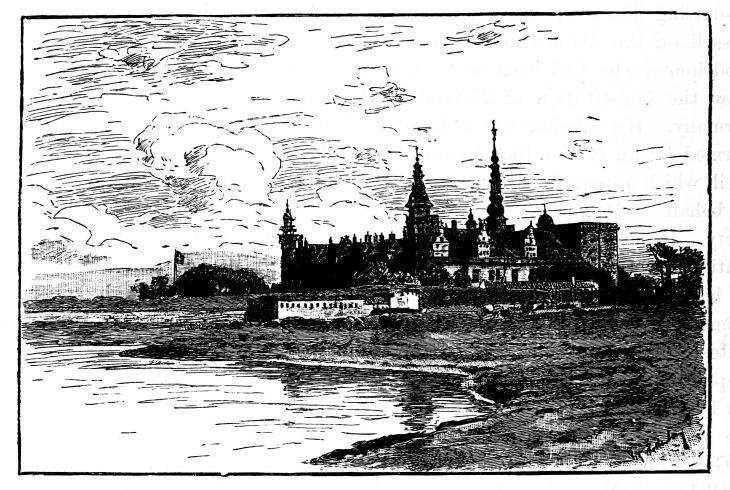
The case against Austria, Prussia, and the Diet was capable of easy statement in a popular form. Hence it is not surprising that the large class of
KRONBORG CASTLE, ELSINORE.
Englishmen who act on what may be called the public schoolboy theory of high politics took the side of the Danes. Denmark was a small Power, whereas Austria and Prussia were two large Powers, who were “bullying” Denmark. Austria, Prussia, and most of the minor States of Germany did not come into court with clean hands. They had individually sanctioned the Treaty of London, to which they now objected, because the German Diet, of which they were members, had not ratified it. They refused to be bound by it because Denmark had violated antecedent engagements, made independently of it, and on another subject than the Danish Succession, with which the Treaty dealt. Austria and Prussia could hardly be disinterested in coming forward as the champions of Constitutionalism, and “the doctrine of nationalities” in Sleswig and Holstein. The Treaty of London of 1852 was the work of England, and to uphold it by arms was a debt of honour which Englishmen ought to pay. The big-boy-and-the-small-boy argument was founded on a strange misconception of the facts. In Holstein and Sleswig the
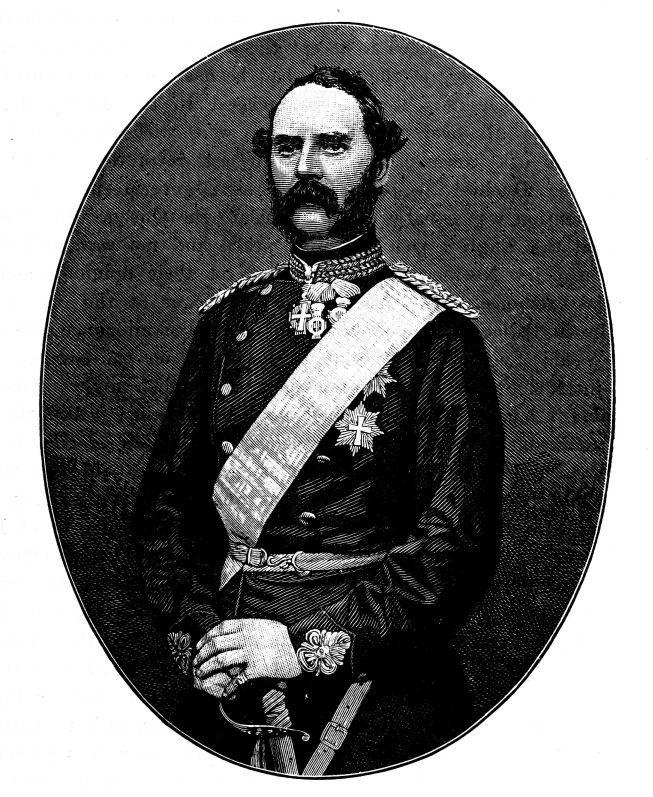
CHRISTIAN IX., KING OF DENMARK.
Danes played the part of the big boy who was bullying the little one. When they were asked to hold their harsh hand by stronger Powers they



